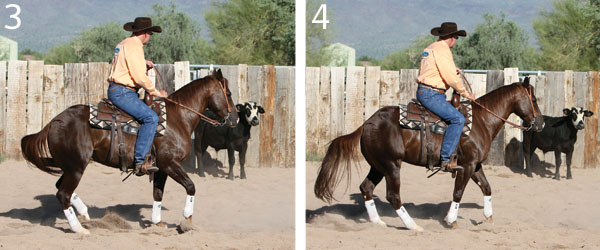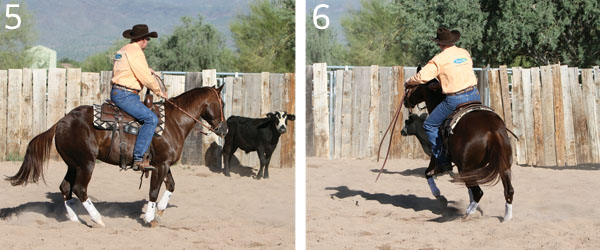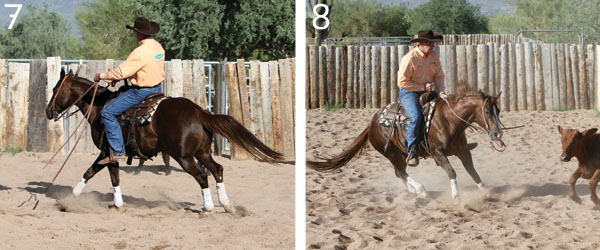Boxing a cow (working him at the short end of the arena) is all about your horse’s focus, his ability to read a cow, and his readiness to move with that cow in a split second. When your horse is stopped parallel with the cow, your horse must maintain that focus. However, sometimes your horse might lose his intensity, forget about the cow, and stand dull and flat-footed. Your horse isn’t ready, which puts him at a severe disadvantage when the cow makes a move. That’s when this exercise comes in handy. I call it “driving the cow.”
Here, I’ll show you the steps for this exercise to try at home. It should help your horse regain his focus and be more responsive to do his job. In these photos, I’m using a shanked bit with split reins, alternating between one- and two-handed riding. Use whatever bit setup your horse is most comfortable in, and use two hands on the reins whenever you feel your horse needs the extra support.
1. My horse is tracking with the cow down the fence. As the cow prepares to stop, so does my horse. They’ll stop parallel to each other and the fence. Ideally, my horse should make a solid stop, but be ready to initiate the cow’s next move.

2. I’ve stopped with the cow. This is when my horse could lose intensity and focus, demonstrated by standing flat-footed rather than ready to move, and giving a dull expression. A horse with this attitude is sure to lose that cow as soon as it turns to run in the opposite direction. When I notice a lack of attention, I begin my “driving the cow” drill.
3. After coming to a complete stop, I back my horse a few steps to get him on his hind end, rather than standing flat-footed. When he’s flat-footed, he’s at a severe disadvantage; he’s not coiled up and ready to move with that cow. When my horse is on his hindquarters, he’s more able to spring to action with the cow.

4. I stop backing once my horse’s nose is in line with the cow’s hip. This helps my horse connect to the cow and think about initiating the cow’s movement. I want my horse to read the cow—that is, initiate a cow’s movement and go with it or react to the cow’s movement.
5. With my horse’s nose at the cow’s hip, I cue for a turn toward the cow. I use my inside rein to begin the turn and my outside leg to straighten out my horse once I’ve completed a 180-degree turn. This stop-back-turn sequence tells my horse to stop, hunt the cow, pick up your front end, be athletic, and sweep across the cow smoothly. If my horse seems too dull or flat-footed, I’ll sweep through a 180-degree turn to the left and the right, to get my horse’s attention and move his feet. I sometimes sweep back and forth a few times.

6. When my horse began his turn, he connected with the cow and made the cow turn 180 degrees, too. You can see that my horse has his weight on his hind end, pivoting over his hindquarters like they’re on an axis. It’s important that my horse gives to the pull of my inside rein, bends readily, and yields to my leg pressure to straighten out for this exercise to be effective.
7. We’re headed back down the fence with the cow. When my horse stops again, he should be ready to move with the cow—with his weight on his hindquarters, his face ready to yield to my rein cues, and his body responsive to my leg cues. By repeating this drill, my horse becomes more attached to the cow and better uses his hind end to drive the cow.

8. Here’s what I’m talking about, in terms of my horse being coiled up and ready to work the cow. His weight is on his hindquarters, his front legs are making a snappy turn across the cow, and his expression shows that he’s reading that cow. All of this comes together for a horse that’s ready to work, attentive, and dynamic to the cow’s movement.
Al Dunning, Scottsdale, Arizona, has produced world champion horses and riders in multiple disciplines. He’s been a professional trainer for more than 40 years, and his expertise has led him to produce books, DVDs, and his own online mentoring program, Team AD International (teamadinternational.com).






